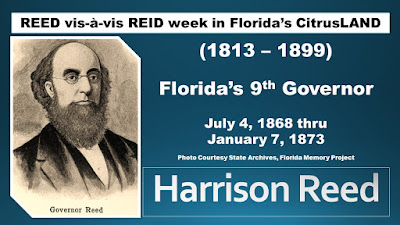REED & REID names are found often in the story of 19th
century central Florida. Fort REID was only the second settlement south of Lake
Monroe, founded in 1842 after the Army departed, thinking they had ended the
Indian War. Much of East Orange County has its origins in an Englishman named
REED, while Orlando, well it could have become a ghost town had it not been for
Robert R. REID of Palatka.
People named Reed and Reid had been so involved in the early
days of central Florida development that historians began getting them
confused. So for the sake of Righting History, the mission of REED vis-à-vis
REID Week is to sort one from the other. A six part series featuring six
different pioneering families having similar names, I wrap up my series shining
the spotlight on George REED, a determined Connecticut merchant whose motto had
to be, “if at first you don’t succeed….”
Village of Tontogany, Ohio, 25 miles southwest of Toledo,
flourished in the 1870s in part because a railroad line from Cincinnati pushed
northward in the direction of Toledo. A native of Connecticut, George and Sarah
REED moved west, and by 1860, had settled in Ohio. George REED opened a store
at Tontogany, and by 1875, was a Councilman. “The Tontogany fire of December
31, 1876,’ says a Wood County, Ohio history, “destroyed Black & Ingraham’s
drug store, William Allen’s store, George REED’s Store, the Masonic Hall above
it; Cooley’s Grocery, and Ridgeway’s tailor shop.”
REED picked himself up, dusted himself off, and by 1884 had
relocated to Forest City, an up and coming new Orange County town founded by
Cleveland Department Store owner John G. HOWER. George REED was appointed
Forest City Postmaster March 19, 1884, and the following year, Webb’s
Historical described the town as: “three and one-half miles from the South
Florida Railway.”
Orange Belt Railway began serving Forest City by 1886, and
where a Target Department Store stands today at SR 436 and Forest City Road
stood, in the 1890s, “a handsome rail depot, complete with a telegraph office.”
On the western outskirts of Forest City was the residence and grove of George
REED, overlooking Pearl Lake. Then came Florida’s great freeze of 1894-95,
wiping out most every grower and citrus tree.
Journey aboard Orange Belt Railway
Sanford to Oakland, Florida
Available at Amazon.com
Prior to the freeze, Fred H. REED, son of George & Sarah,
had gone out on his, and had both participated in and staked a claim during
Oklahoma’s Land Rush of 1889. George and Sarah, nearing their 70s when the
freeze destroyed their Forest City grove, moved on once again, this time to
Oklahoma City. Son Fred, a merchant by then, had opened a furniture store,
following in his father’s footsteps.
Whatever anyone might say of the Reid and Reeds of early
central Florida one thing is for certain – they were all, in their own special
way, a hardy bunch.
MY SUNDAY
SUMMER SERIES BEGINS, MAY 6, 2018
50 STATES
OF CENTRAL FLORIDA
Each
Sunday through Labor Day!
Access Amazon.com Ghost Towns Book via this link:

















